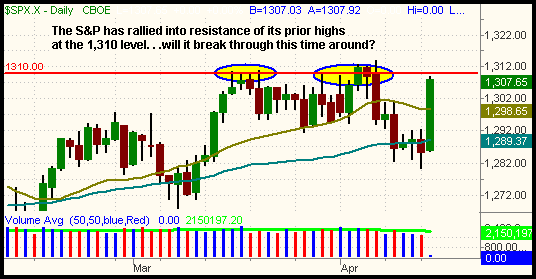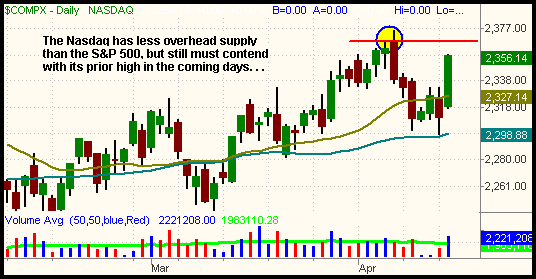The long-awaited return of institutional trading activity sparked a powerful broad-based rally that launched both the S&P 500 and Nasdaq Composite to their best percentage gains since April 17, 2005. Stocks gapped up moderately on the open, trended higher throughout the first half of the session, then surged parabolically after the reading of the Fed minutes at 2:00 pm EDT. Comments that implied the Federal Reserve Board may be finished with their series of rate increases was the impetus for the favorable reaction. The Nasdaq Composite soared 2.0%, while both the S&P 500 and Dow Jones Industrials kept pace with gains of 1.7% and 1.8% respectively. The small-cap Russell 2000 vaulted higher by an impressive 2.8%, as did the S&P Midcap 400 with its 2.2% gain. Each of the major indices also closed at their best levels of the session, indicating no immediate sign of traders selling into strength.
Tremendous market internals were the underlying reason for yesterday's momentum. For starters, total volume in the NYSE spiked 39%, while volume in the Nasdaq was 24% higher than the previous day's level. It was the highest turnover in the NYSE since March 17, which was certainly a welcome change from three weeks of below average volume. But the real kicker was the unbelievable ratio of advancing volume to declining volume in the broad market. In the NYSE, advancing volume blew away declining volume by a whopping margin of more than 9 to 1!! The Nasdaq's ratio was positive by more than 6 to 1. Since inception of The Wagner Daily newsletter nearly four years ago, we honestly cannot recall ever seeing that ratio as high as it was in the NYSE. Clearly, one would have been hard pressed to find any areas of major selling activity yesterday.
Needless to say, we stopped out of our short positions in SPY and DIA yesterday. However, we don't regret entering the trades because, in our opinion, the reasons for entry were completely valid and justified. When analyzing a trade that did not work out very well, the one question we always ask ourselves is, "Knowing what I now know in hindsight, would I still make the same trade if I had the chance to do it all over again?" If the answer to that question is "yes," then there is never a need to feel bad about a loss. All professional traders will have times when they were just plain wrong, but the way to become a consistently profitable trader is to simply follow your plan in both good times and bad. This means you only need to let the winning trades ride for maximum profitability, while simply being disciplined to stick with the stop losses on your losing trades.
So how did yesterday's action change our view of the broad market looking forward? Primarily, it tells us that all bets are off on the short side of the market unless stocks come right back down to where they started from. While this is unlikely, nothing would surprise us given the market's erratic action over the past several months. Conversely, it seems a bit premature to blindly go on a buying spree because of one strong day of gains. It would be a different story if the major indices were already sitting at new highs and devoid of overhead supply, but that is not the case. The S&P 500, for example, must still overcome resistance of its prior highs of the past month. As the horizontal line on the chart below illustrates, the 1,310 area has acted like a brick wall on numerous occasions since March 16:

The Nasdaq has less overhead supply than the S&P, but it too remains below its prior high:

As has been the situation for the past several years, both the S&P Midcap 400 and small-cap Russell 2000 indices are again leading the S&P and Nasdaq. Both indices set new all-time closing highs yesterday, but finished just below their respective intraday highs of April 7. If entering new long positions, you might consider the small and mid-cap stocks and ETFs because there is more relative strength and less overhead in those sectors.
Earnings season is in full swing now, so be cognizant of key earnings reports in the coming weeks. After the close of trading, Texas Instruments, Yahoo!, IBM, and Motorola were among the major companies who reported their results. Of the four, Motorola was the only company whose stock traded lower in the after-hours market. Apple Computer, Intel, Coca-Cola, and eBay, along with a slew of other companies, report their quarterly earnings today.
Deron Wagner is the Founder and Head Trader of both Morpheus Capital LP, a U.S. hedge fund, and Morpheus Trading Group, a trader education firm launched in 2001 that provides daily technical analysis of the leading ETFs and stocks. For a free trial to the full version of The Wagner Daily or to learn about Wagner's other services, visit MorpheusTrading.com or send an e-mail to deron@morpheustrading.com.